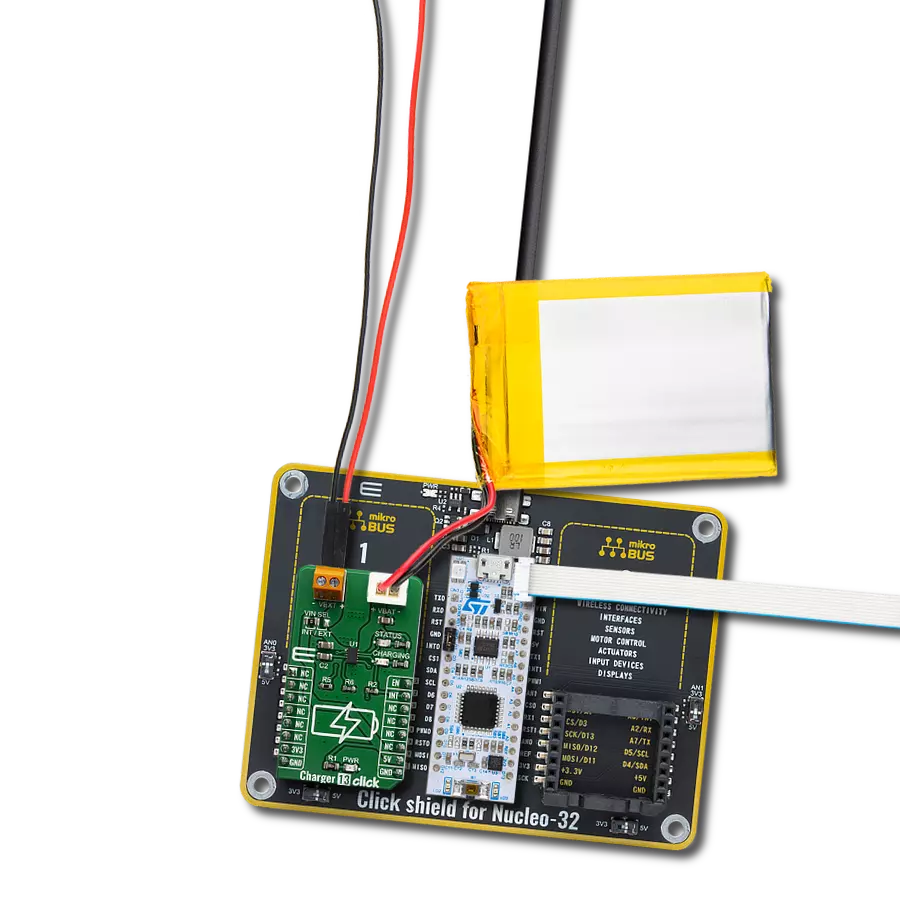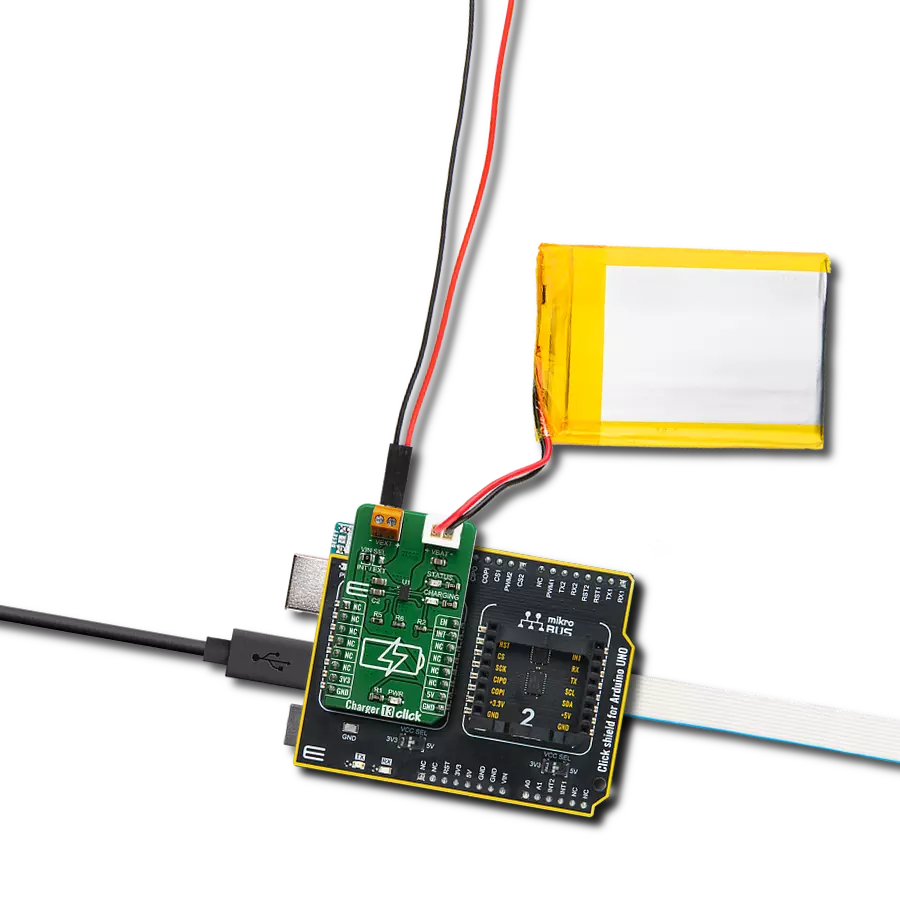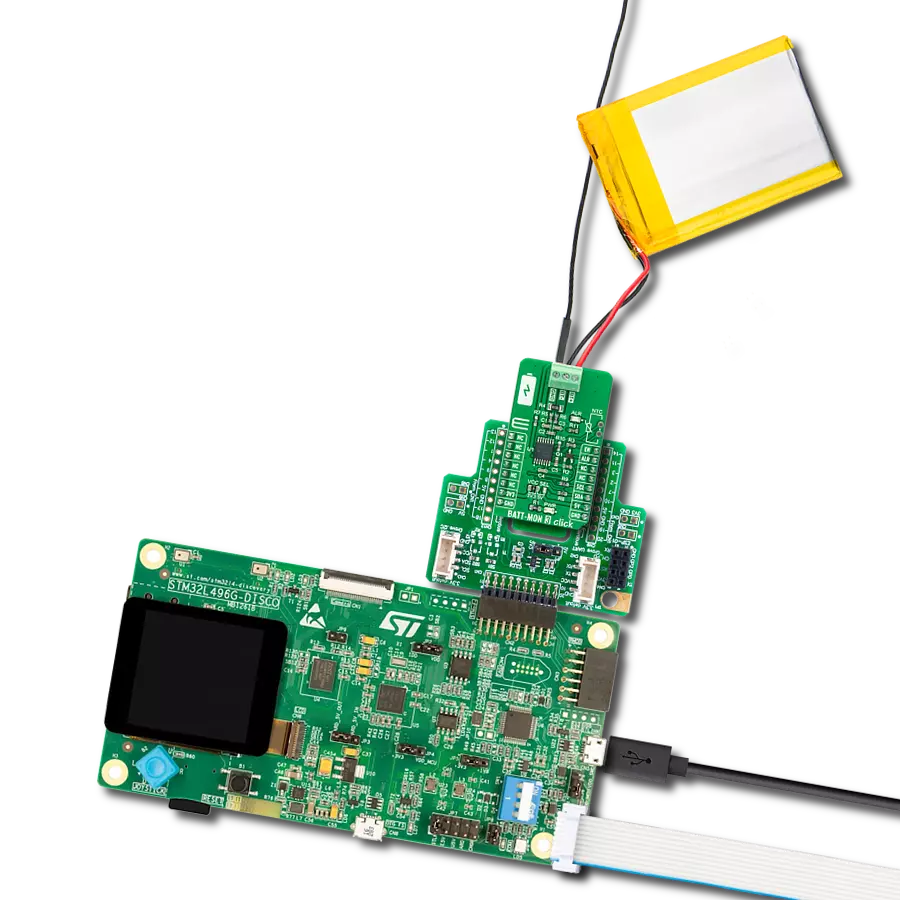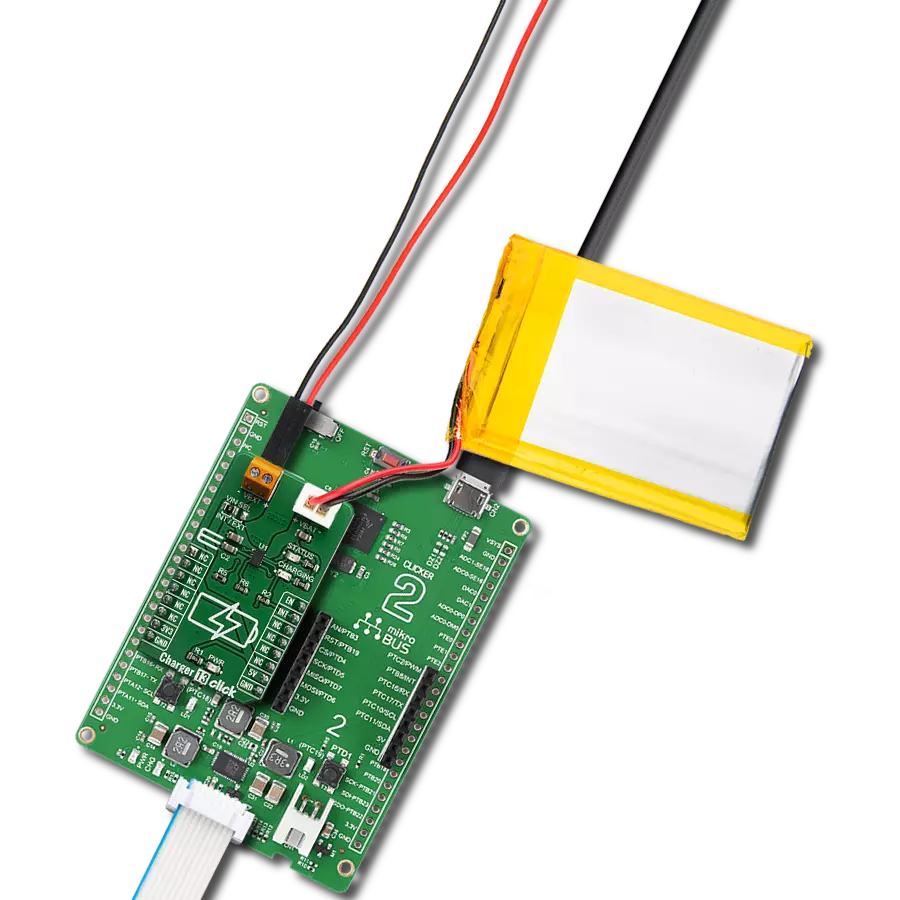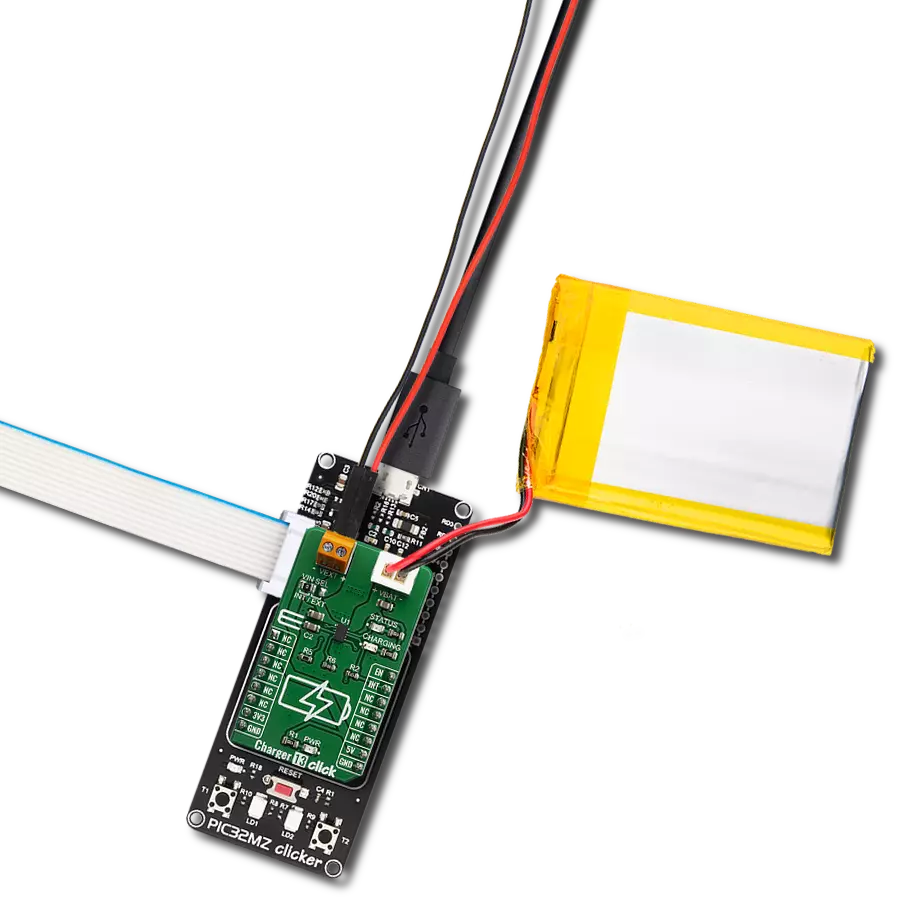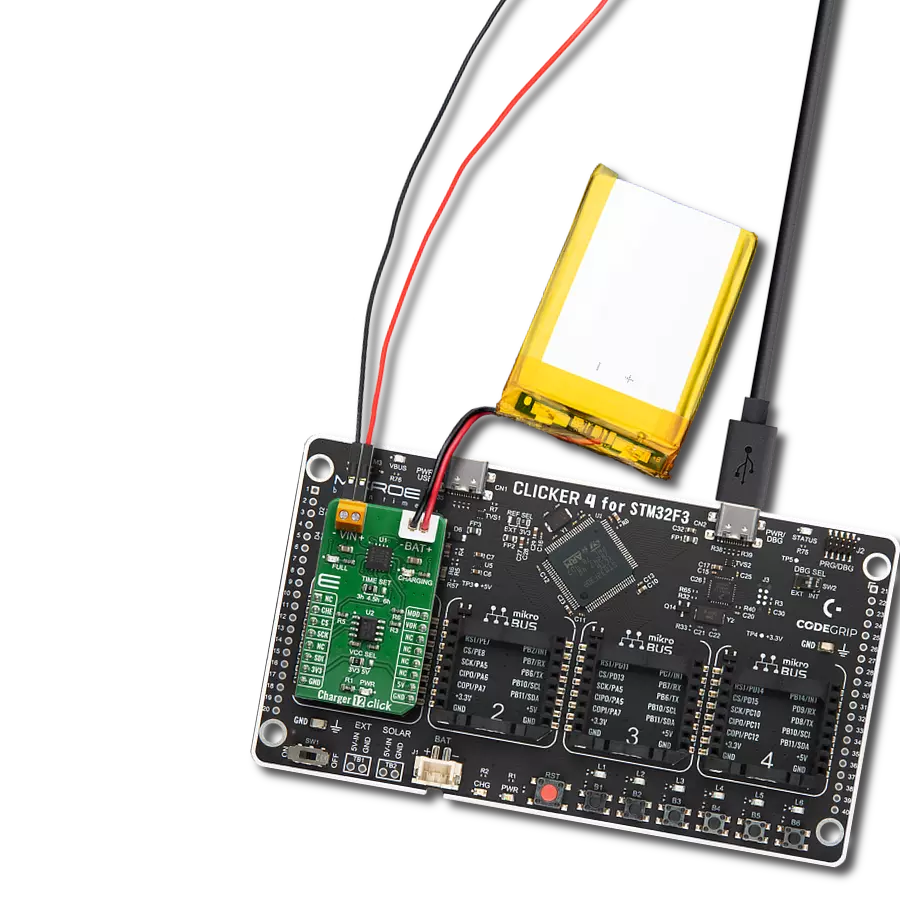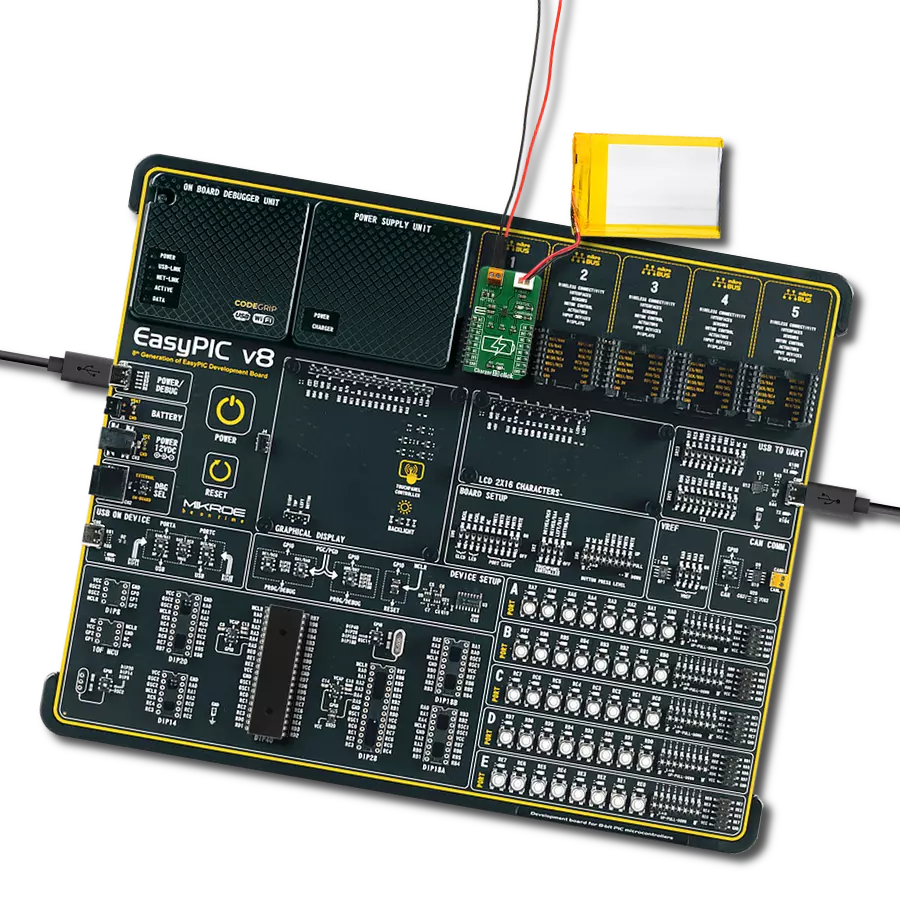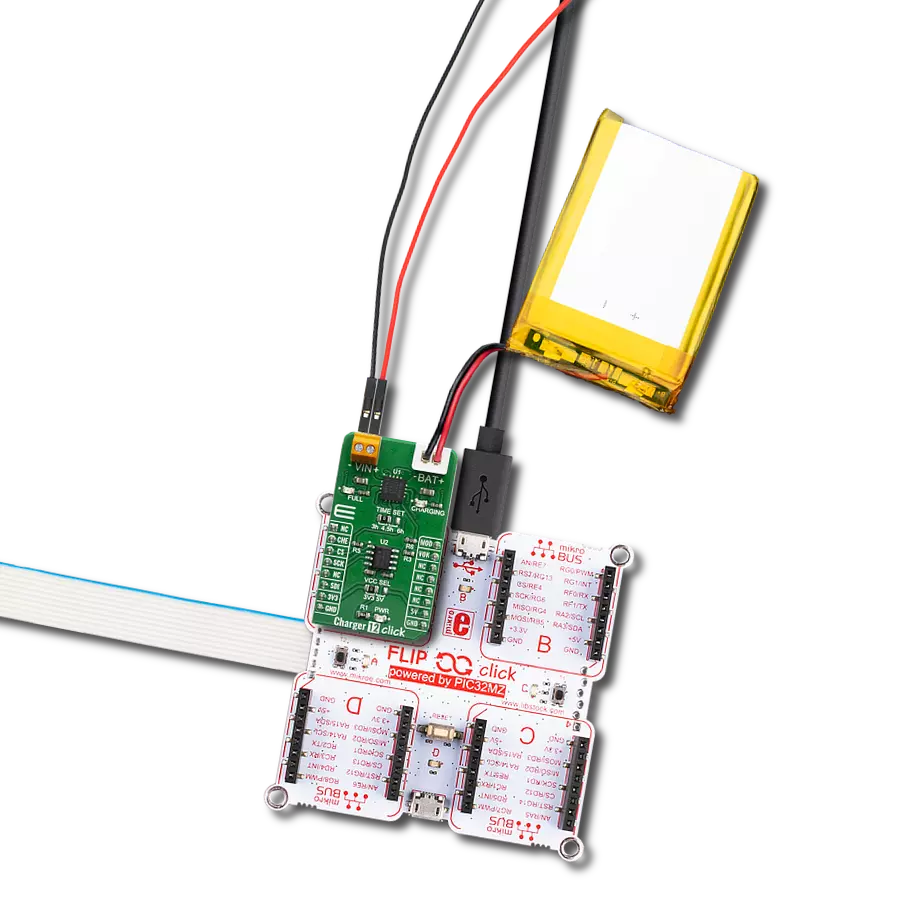Ready to see the transformative impact of our high-performance battery charger on your solution? Let's embark on the journey together.
A
A
Hardware Overview
How does it work?
Charger 12 Click is based on the MAX1501, a highly integrated, linear battery charger with thermal regulation for portable applications from Analog Devices. The MAX1501 is an efficient Lithium-Ion battery charger, thanks to Microprocessor-Controlled specific charge algorithms for Li-Ion batteries to achieve optimal capacity and safety in the shortest charging time possible. Besides its small physical size, the low number of external components makes this IC ideal for various applications. The 4.2V factory preset reference voltage simplifies design. A digital potentiometer sets the fast charge constant current, the MCP4161, an 8-bit digital potentiometer from Microchip, with an external 1.5KΩ resistor in series. Thanks to proprietary programmable die temperature regulation, MAX1501 can limit the charge current based on the temperature during high power or ambient conditions. This thermal regulation optimizes the charge cycle time while maintaining device reliability. The MAX1501 IC is designed with reliability in mind: the IC prevents draining the battery below the protects it from overheating
(if the thermistor is used), critical level, offers prequel charging (for deeply depleted batteries), features overvoltage protection, charging status monitoring and more. The Click board™ is equipped with indicators to monitor the charging process and power distribution: CHARGE LED indicates the charge-in-progress status, and FAULT LED indicates an error during the charging process. The digital potentiometer on Charger 12 click is MCP4161 which offers a wide range of product offerings using an SPI interface. WiperLock technology allows application-specific calibration settings to be secured in EEPROM. This digital pot is tied with a charger IC over its wiper (P0W) pin. Battery charging can be controlled by assigning values on MCP4161 from 0 to 10-kilo ohms. As there is a 1.5K resistor in series, it can never be 0 ohms on the MAX1501 charger's PROG pin. However, maximum resistance cannot exceed 11.5 kiloohms. Fast charging can be regulated with 10K on the PROG pin to get 130 mA. To get 1000 mA digital potentiometer needs to go down to 0Ohm, along with an external resistor, which
makes 1.5K. Communication with a digital potentiometer on this Click, controlling the charger, is done through the SPI interface. On the left side of the click board is an input screw terminal with corresponding markings, where the recommended external voltage of 6V can be applied. The left screw terminal is reserved for a Lithium Iron Phosphate battery with GND and VBAT+ markings. The green PWR LED will indicate it when connected to a power source. Red LED1 and green LED2 can be used for visual charge monitoring. These two LEDs are multipurpose and can be used for various things. This Click board™ can operate with either 3.3V or 5V logic voltage levels selected via the VCC SEL jumper. This way, both 3.3V and 5V capable MCUs can use the communication lines properly. However, the Click board™ comes equipped with a library containing easy-to-use functions and an example code that can be used, as a reference, for further development.
Features overview
Development board
PIC18F57Q43 Curiosity Nano evaluation kit is a cutting-edge hardware platform designed to evaluate microcontrollers within the PIC18-Q43 family. Central to its design is the inclusion of the powerful PIC18F57Q43 microcontroller (MCU), offering advanced functionalities and robust performance. Key features of this evaluation kit include a yellow user LED and a responsive
mechanical user switch, providing seamless interaction and testing. The provision for a 32.768kHz crystal footprint ensures precision timing capabilities. With an onboard debugger boasting a green power and status LED, programming and debugging become intuitive and efficient. Further enhancing its utility is the Virtual serial port (CDC) and a debug GPIO channel (DGI
GPIO), offering extensive connectivity options. Powered via USB, this kit boasts an adjustable target voltage feature facilitated by the MIC5353 LDO regulator, ensuring stable operation with an output voltage ranging from 1.8V to 5.1V, with a maximum output current of 500mA, subject to ambient temperature and voltage constraints.
Microcontroller Overview
MCU Card / MCU

Architecture
PIC
MCU Memory (KB)
128
Silicon Vendor
Microchip
Pin count
48
RAM (Bytes)
8196
You complete me!
Accessories
Curiosity Nano Base for Click boards is a versatile hardware extension platform created to streamline the integration between Curiosity Nano kits and extension boards, tailored explicitly for the mikroBUS™-standardized Click boards and Xplained Pro extension boards. This innovative base board (shield) offers seamless connectivity and expansion possibilities, simplifying experimentation and development. Key features include USB power compatibility from the Curiosity Nano kit, alongside an alternative external power input option for enhanced flexibility. The onboard Li-Ion/LiPo charger and management circuit ensure smooth operation for battery-powered applications, simplifying usage and management. Moreover, the base incorporates a fixed 3.3V PSU dedicated to target and mikroBUS™ power rails, alongside a fixed 5.0V boost converter catering to 5V power rails of mikroBUS™ sockets, providing stable power delivery for various connected devices.
Li-Polymer Battery is the ideal solution for devices that demand a dependable and long-lasting power supply while emphasizing mobility. Its compatibility with mikromedia boards ensures easy integration without additional modifications. With a voltage output of 3.7V, the battery meets the standard requirements of many electronic devices. Additionally, boasting a capacity of 2000mAh, it can store a substantial amount of energy, providing sustained power for extended periods. This feature minimizes the need for frequent recharging or replacement. Overall, the Li-Polymer Battery is a reliable and autonomous power source, ideally suited for devices requiring a stable and enduring energy solution. You can find a more extensive choice of Li-Polymer batteries in our offer.
Used MCU Pins
mikroBUS™ mapper
Take a closer look
Click board™ Schematic

Step by step
Project assembly
Track your results in real time
Application Output
1. Application Output - In Debug mode, the 'Application Output' window enables real-time data monitoring, offering direct insight into execution results. Ensure proper data display by configuring the environment correctly using the provided tutorial.

2. UART Terminal - Use the UART Terminal to monitor data transmission via a USB to UART converter, allowing direct communication between the Click board™ and your development system. Configure the baud rate and other serial settings according to your project's requirements to ensure proper functionality. For step-by-step setup instructions, refer to the provided tutorial.

3. Plot Output - The Plot feature offers a powerful way to visualize real-time sensor data, enabling trend analysis, debugging, and comparison of multiple data points. To set it up correctly, follow the provided tutorial, which includes a step-by-step example of using the Plot feature to display Click board™ readings. To use the Plot feature in your code, use the function: plot(*insert_graph_name*, variable_name);. This is a general format, and it is up to the user to replace 'insert_graph_name' with the actual graph name and 'variable_name' with the parameter to be displayed.

Software Support
Library Description
This library contains API for Charger 12 Click driver.
Key functions:
charger12_generic_transfer- Generic transfercharger12_mode_select- Charger mode selectioncharger12_spi_set_register- This function set spi register
Open Source
Code example
The complete application code and a ready-to-use project are available through the NECTO Studio Package Manager for direct installation in the NECTO Studio. The application code can also be found on the MIKROE GitHub account.
/*!
* \file
* \brief Charger12 Click example
*
* # Description
* This application charges the batery.
*
* The demo application is composed of two sections :
*
* ## Application Init
* Iniztializes SPI driver.
*
* ## Application Task
* Executes additional functions based on user input.
*
* *note:*
* Additional Functions :
* - charger12_case_Plus() - Increments Wiper position.
* - charger12_case_Minus() - Decrements Wiper position.
* - charger12_case_One() - Selects 1st mode of operation.
* - charger12_case_Two() - Selects 2nd mode of operation.
* - charger12_case_Three() - Selects 3rd mode of operation.
* - charger12_case_Four() - Selects 4th mode of operation.
*
* \author MikroE Team
*
*/
// ------------------------------------------------------------------- INCLUDES
#include "board.h"
#include "log.h"
#include "charger12.h"
// ------------------------------------------------------------------ VARIABLES
static charger12_t charger12;
static log_t logger;
void charger12_case_plus( )
{
log_printf( &logger, "> Wiper incremented" );
charger12_spi_increment_wiper( &charger12 );
log_printf( &logger, "\r\n" );
}
void charger12_case_minus( )
{
log_printf( &logger, "> Wiper decremented" );
charger12_spi_increment_wiper( &charger12 );
log_printf( &logger, "\r\n" );
}
void charger12_case_one( )
{
charger12_mode_select( &charger12, CHARGER12_MODE_Li );
log_printf( &logger, "> Mode : Li+ Charge");
log_printf( &logger, "\r\n" );
}
void charger12_case_two( )
{
charger12_mode_select( &charger12, CHARGER12_MODE_NiMh_NiCd );
log_printf( &logger, "> Mode : NiMH/NiCd Charge" );
log_printf( &logger, "\r\n" );
}
void charger12_case_three( )
{
charger12_mode_select( &charger12, CHARGER12_MODE_DISABLE );
log_printf( &logger, "> Mode : Disable" );
log_printf( &logger, "\r\n" );
}
void charger12_case_four( )
{
charger12_mode_select( &charger12, CHARGER12_MODE_NO_BATTERY );
log_printf( &logger, "> Mode : No Battery" );
log_printf( &logger, "\r\n" );
}
void application_init ( void )
{
log_cfg_t log_cfg;
charger12_cfg_t cfg;
/**
* Logger initialization.
* Default baud rate: 115200
* Default log level: LOG_LEVEL_DEBUG
* @note If USB_UART_RX and USB_UART_TX
* are defined as HAL_PIN_NC, you will
* need to define them manually for log to work.
* See @b LOG_MAP_USB_UART macro definition for detailed explanation.
*/
LOG_MAP_USB_UART( log_cfg );
log_init( &logger, &log_cfg );
log_info( &logger, "---- Application Init ----" );
// Click initialization.
charger12_cfg_setup( &cfg );
CHARGER12_MAP_MIKROBUS( cfg, MIKROBUS_1 );
charger12_init( &charger12, &cfg );
Delay_ms ( 100 );
charger12_mode_select( &charger12, CHARGER12_MODE_DISABLE );
Delay_ms ( 100 );
log_printf( &logger, "> App init done" );
}
void application_task ( void )
{
charger12_case_plus( );
Delay_ms ( 1000 );
charger12_case_minus( );
Delay_ms ( 1000 );
charger12_case_one( );
Delay_ms ( 1000 );
charger12_case_two( );
Delay_ms ( 1000 );
charger12_case_three( );
Delay_ms ( 1000 );
charger12_case_four( );
Delay_ms ( 1000 );
}
int main ( void )
{
/* Do not remove this line or clock might not be set correctly. */
#ifdef PREINIT_SUPPORTED
preinit();
#endif
application_init( );
for ( ; ; )
{
application_task( );
}
return 0;
}
// ------------------------------------------------------------------------ END
Additional Support
Resources
Category:Battery charger
























